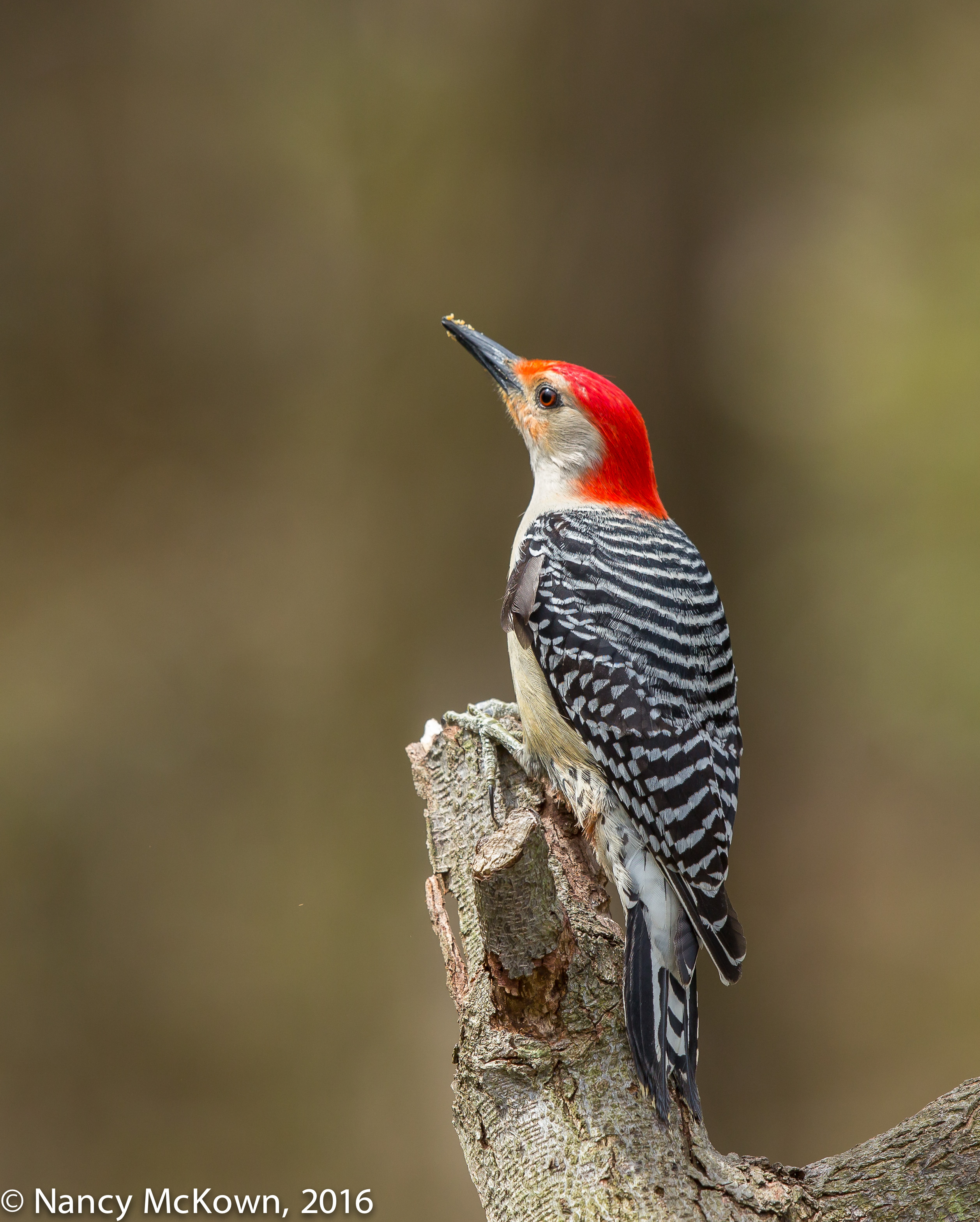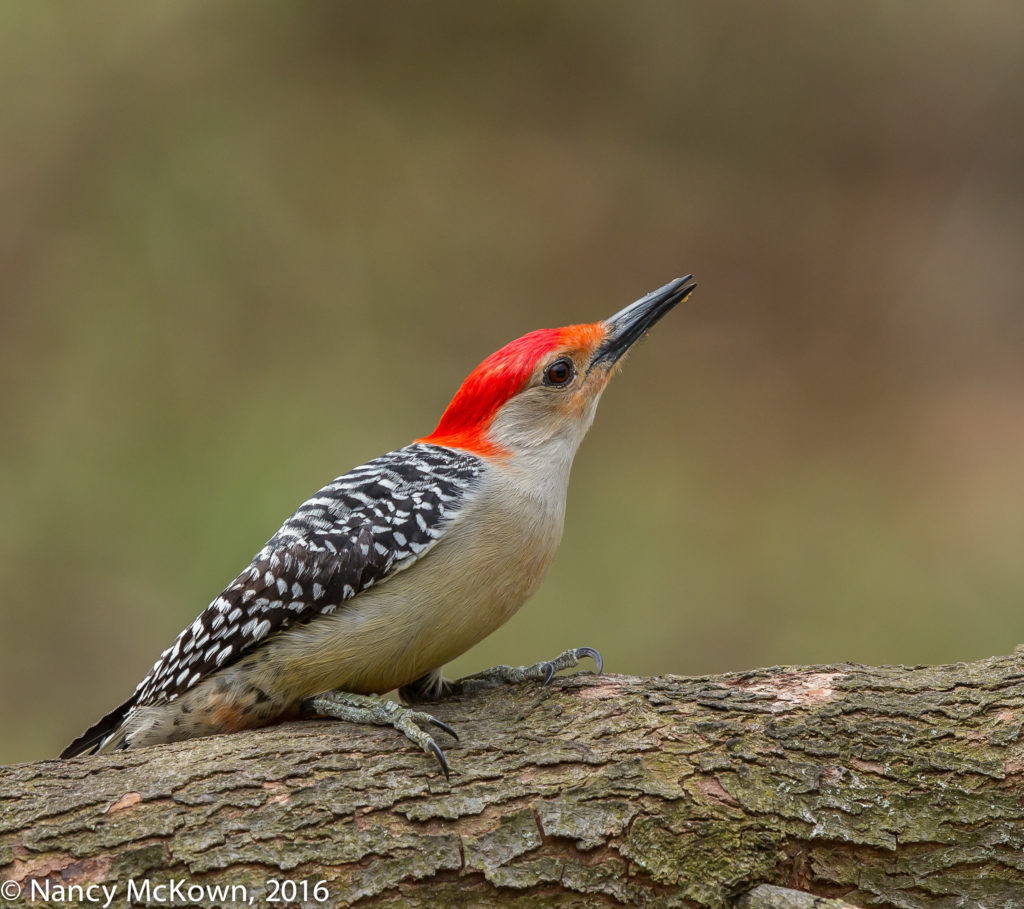Photographing Red Bellied Woodpeckers
An assortment of Woodpeckers live in or visit our heavily wooded yard, but the Red Bellied is the most prominent year round resident. (Odd name, since only a slight tint of red can be found on their bellies.) The males sport a prominent red crown, right above that chiseling beak common to woodpeckers. While probing and excavating for food, these birds strategically prop their tail feathers down on their perch for balance. Most prominent on all woodpeckers are their oversized clinging 4 toed feet (zygodactyl – two toes forward, two toes back). Drumbeat roll from these guys tap-tap-tapping on trees =19 taps per second.
Red Bellied Woodpeckers are easy to photograph because they often cling to bare tree trunks and inch up and down methodically with their back feathers dragging behind. This male Red Bellied posed for me on a limb with ample morning light and no background distractions. He stayed less than a minute, but it was long enough for me to capture a couple shots.
Red Bellied Woodpecker
ISO500; f/7.1; 1/640 Second
Read all About It
Can’t help but notice that Canon’s newest flagship camera (EOS-1D X Mark II) was due out in the Spring of 2016- right about now. Apparently, stores like Adorama, B&H, and others offered sample prototypes (for a day, a week?) to their favorite (and incredibly lucky!) photographers in exchange for writing a review. (Some restrictions did apply on the type of photos they could publish.) These teaser reviews get photographers like me salivating about owning a camera that is packed with spectacular image quality and state of the art creative control.

ISO400; f/7.1; 1/640 Second
Crazy?
Am I CRAZY to want to own this camera? The updated EOS-1D X Mark II is very pricy–$5999- too pricy considering that it’s not a good long term investment. Top of the line DSLR professional cameras do not keep their value like Canon’s premium lenses.
Like computers, every camera upgrade brings enhanced speed, quality, and capacity- so much so that, after getting use to it, you wonder how you got along without it. For the last 15-20 years, I’ve always purchased Canon’s 2nd tier and 3rd tier more affordable DSLR cameras. These cameras are enticing because they typically contained two or three components that have trickled down from Canon’s best imaging technology.
Bottom line: 5 years ago I would have scoffed at the idea of buying this camera. I always presumed that the whole flagship DSLR camera package was not only out of my reach, but unnecessary. At this point in my photographic adventures, I’m considering it.
Expectations and Potential
This newest flagship camera is all about expectations and potential. A few reviewers out there grumble that it’s a toy for the rich and that the enhancements over the last flagship model are just superficial- not worthy the upgraded “Canon D X Mark II” label. But I don’t think so. This camera is an admittedly expensive investment for bird photographers (professionals and amateurs) who take their work seriously and find pure, unadulterated delight in the possibilities of a cutting edge tool.
Camera Aficionado
I’ve always been a camera aficionado, carefully attentive to equipment and always tuned in to pioneering developments as they relates my extravagant fondness for bird photography. New, more complex electronic and mechanical contrivances are an essential part of my challenge. A new camera brings with it an aura of wonder – surprise mingled with admiration–not only because it’s bigger- better-faster, but because I have to understand what makes it tick.
Make no mistake. This new equipment won’t solve problems of poor lighting, entice a Red Bellied Woodpecker to come closer or even show up in the first place. The challenge, the rewards, the adventure, the striving to get better, the thrill of success—all these things are possible with a lesser camera.
But that’s not what I’m looking for at this time in my life. I want to devote time and initiative to new gear (trappings?) that force me to be quick and nimble, go past old boundaries and struggle to better understand the potential and rewards of the new imaging technology.
A Girl Can Dream
When everything’s said and done, this camera sounds fabulous and I want one. It has an advanced Digic 6+ processor and faster bursting, (with enhanced buffer and memory card storage to accomodate), a more precise 360,000 pixel RGB+IR metering sensor, and a more advanced 3D auto focus and tracking system. I can expect to see more comprehensive dynamic range in my images, better detail (in the shadows) at higher ISOs, and better camera stability due to a new springless mirror assembly that minimizes bounce.
I write a lot about sensor quality…. so this is my favorite part. The full size sensor is 20.2 megapixels with increased sensitivity engineered to keep the ISO low when light is scarce, especially in the dark portions of the image. When the light is so inadequate that ISO must rise and compensate (especially in my yard) the quality of high ISO images from this new sensor promises to be much better than its predecessors.
My biggest disappointment so far: No cropped-sensor options; no 4:5, 1:1, APS-C or other crop options as have been included on the 5DS megapixel cameras.
The list goes on and on. Build-wise, it most certainly is rugged enough to outlive me –though probably won’t outlive my interest for the new and exciting.
I will sell the old to make way for the new and bite the bullet. I might hold off on this purchase just to see if other photographers who use this camera day-in and day-out are impressed.
Buyer’s remorse may come, but, on the other hand; “You can get what you want or you can just get old.” (Billy Joel)
NOTE: Press this link for more information on my thoughts about the Canon’s 50 DS R 50 Megapixal cameras.










Nancy,
I agree…buy the camera. It will give you joy…priceless!
Xxoo
Mary
Went from the EOS-1D Mark 4 to 1DX Mark 2 and will never look back. Better focus, better tracking in moderate to good light, files more tweakable without looking phony. Getting more keepers with a much higher burst rate too. Had to get used to full frame after 8 years of a 1.3 crop but that seems to be the only draw back.
Cheers,
Steve – The Owl Man, http://www.larges.ca
Yep. Love it more everyday. Thanks for reading my blog.
Went from the EOS-1D Mark 4 to 1DX Mark 2 and will never look back. Better focus, better tracking in moderate to good light, files more tweakable without looking phony. Getting more keepers with a much higher burst rate too. Had to get used to full frame after 8 years of a 1.3 crop but that seems to be the only draw back.
Cheers,
Steve